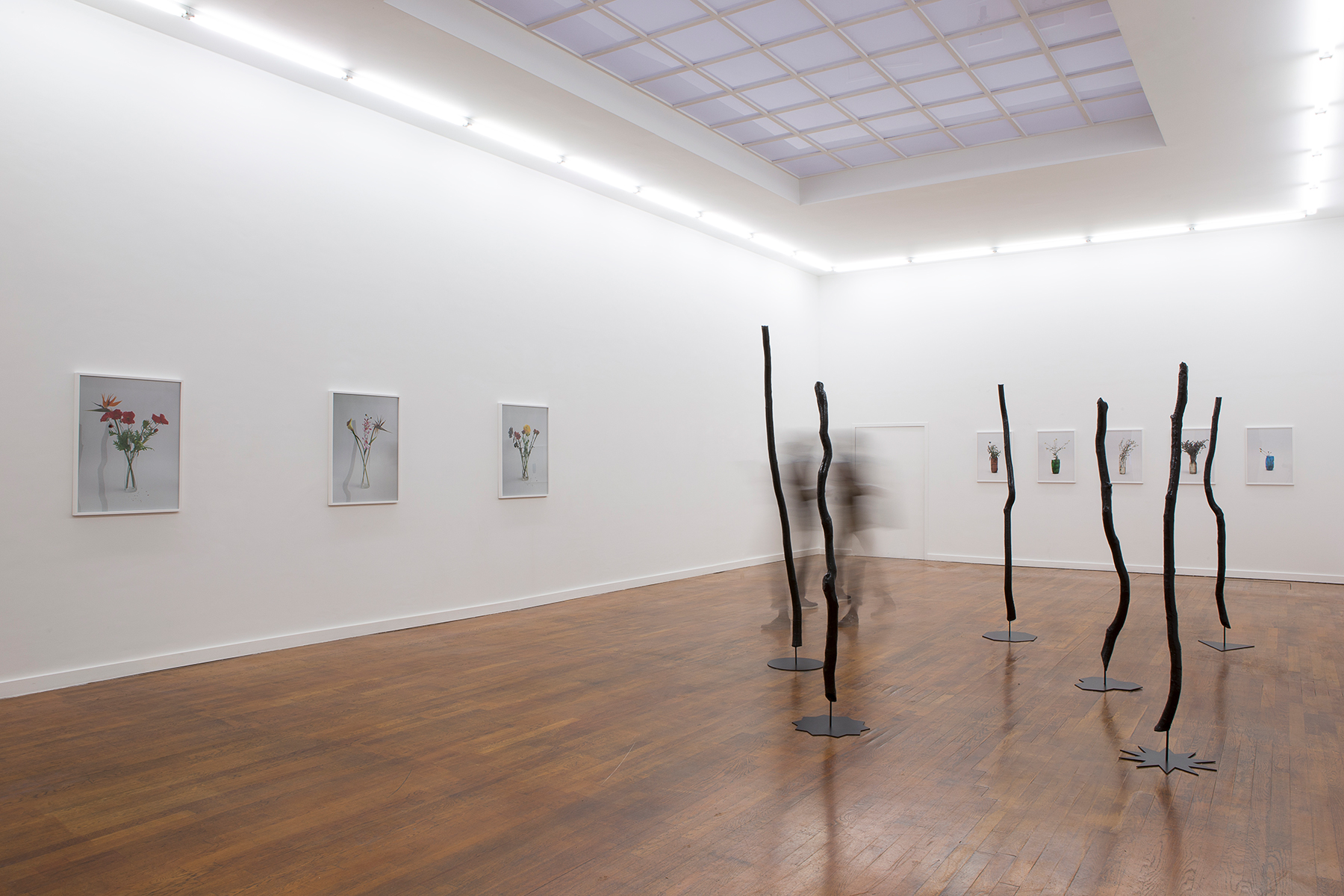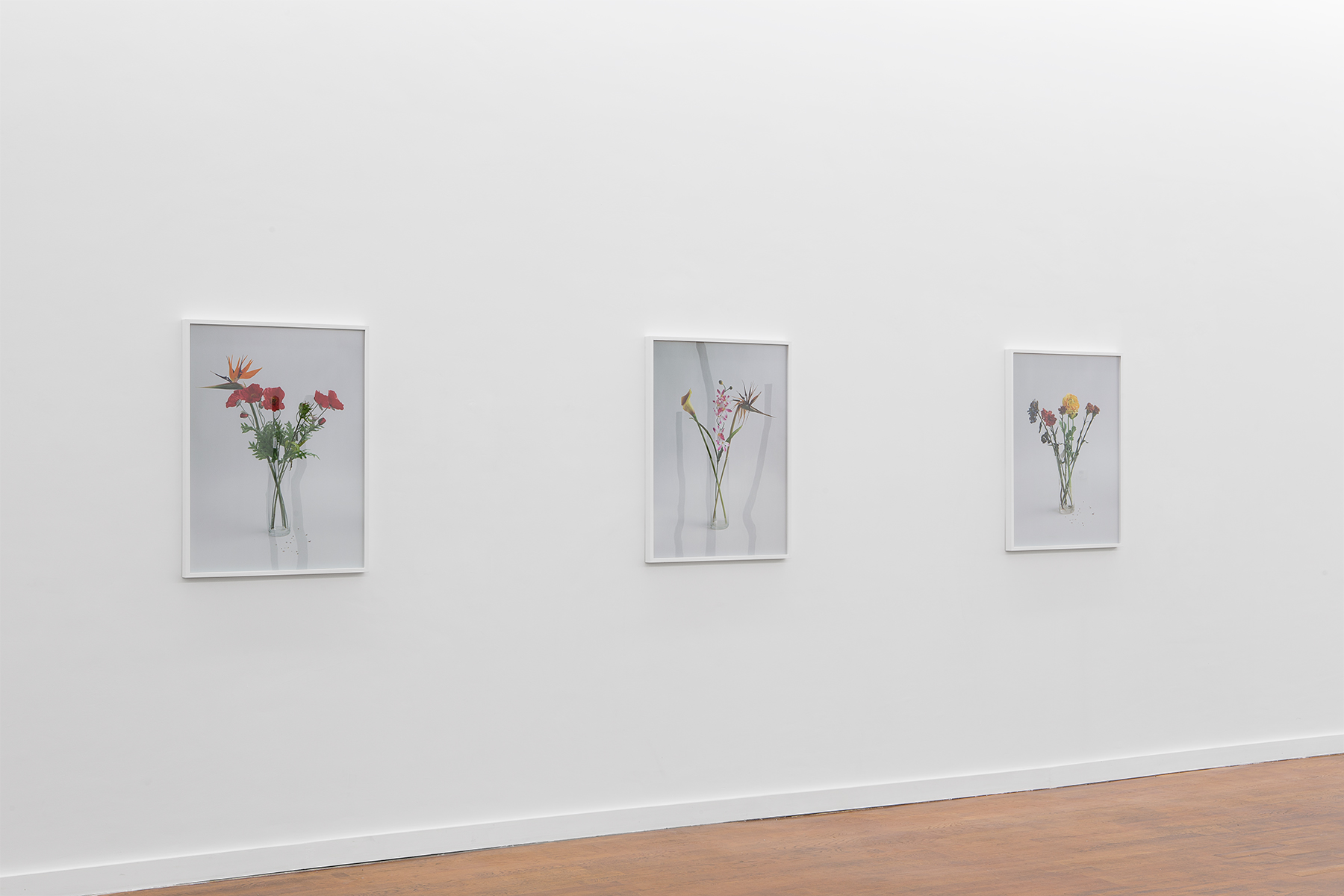This side of paradise
Dauwens & Beernaert gallery, Brussels
Reviewed by Artforum (printed) Summer edition 2016








Adam Vackar chose the title This Side of Paradise by taking inspiration from a poem by Rupert Chawner Brooke (1887–1915) and from the twenty-fourth episode of the science fiction television series, Star Trek.
Finding himself immersed in happiness in Tahiti, Brooke wrote Tiare Tahiti as a love poem and a tribute to the exotic land. Vackar borrows one of the last verses of the poem and turns the feelings of joy into doubt, creating an exhibition that stages a questionable vision of paradise. His photographic series is comprised of two complementary collections: an assortment of artificial flowers combined with natural, wilting flowers, and an array of found objects that depict plastic trash bottles containing bouquets of wildflowers. He also presents an installation with shrink-wrapped tree branches and roots, portraying a kind of contemporary fossil as the wood suffocates beneath the plastic.
Adam Vackar’s other source of inspiration stemmed from Star Trek’s first episode “This Side of Paradise.” In the show, the ship’s crew arrives on a beautiful planet and becomes exposed to flowers expelling toxic spores. They are immediately transformed into peaceful, affectionate people that find themselves attached to the new paradise forever.
Vackar continuously critiques society by staging the growing tension between humanity and its relationship with nature. In his project for Dauwens & Beernaert gallery, he uses his intuition and artistic practice to question the status of post-industrial attitudes. Through sculptures and photographs, he stages a confrontation between materialist and non-material understanding of various aspects of ontology by using the incongruity of nature and artificiality.
Artforum review written by Noemi Smolik
Translated from German by Gerrit Jackson
Artforum / 549 / summer intl review 2016
Gorgeous color photographs, as elegant and beguiling as advertising pictures, show crisply lighted vases holding a variety of bouquets before white backdrops. The steles set up at the gallery’s center are no less elegant. And yet something about this installation by the Prague-based artist Adam Vačkář doesn’t feel quite right. The series of bouquets, created in 2014, bears the title Beautiful and Damned, and they are no doubt beautiful—but it’s not readily apparent why they would be damned. Look more closely, however, and you’ll discover that some of the flowers in the bouquets, slipped in among others gleaming in diverse colors, have wilted. And those fresh flowers are in fact artificial, mostly Chinese merchandise. However perfect the bouquets may look at first glance, impermanence, blight, even death already inhabit them.
Titled Counterculture, the photographs on the facing wall were taken this year and show plastic bottles Vačkář collected along the banks of the Vltava River in Prague and used as vases for plants growing wild in the locations where he found them. Scraggly withered weeds stick limply out of battered dirty bottles. Still, there is a peculiar beauty to these arrangements.
At the center of the room, six black steles look like objects made using a 3D printer but are actually simple tree branches wrapped in packing foil. They are supported by metal feet whose precision-machined computer-generated geometric forms contrast sharply with the irregular organic shapes of the bandaged branches. The installation’s title, This Side of Paradise, was inspired by a poem by Rupert Chawner Brooke. It also alludes to an episode of the science fiction television series Star Trek in which the ship’s crew beam down to an Edenic planet where the spores of a toxic plant fill them with peaceful bliss. Happiness and the paradisiacal beauty of nature clash with mass manufacturing, digitally designed perfection, and the inundation of the planet with industrial products that will never return into the cycle of nature (think of the floating islands of trash in the oceans); the exhibition forges a synthesis between these opposites that is of intoxicating beauty.
The ambivalent quality of nature—in classic aesthetic theory, the embodiment of beauty—and its antithesis, the devastation caused by industrialization; the subliminal affinity between beauty and destruction and death; the energy unleashed when opposites collide: these are the focus of Vačkář’s art. Growing up in Prague, he witnessed how a well-intentioned system, socialism, was perverted: good turned into evil, freedom into servitude, hope into despair. Hence his interest in the sort of phenomena that harbor the potential for such inversion. For the installation Synesthesia (2012), he shot at blank sheet music and then asked a composer to elaborate the hole-riddled “score” into electronic music. A destructive act is given a constructive turn; demolition becomes composition. A paradox, to be sure, but one that attests to a profound insight the French philosopher Alain Badiou, in his Ethics: An Essay on the Understanding of Evil, put as follows: “Evil is possible only through an encounter with the Good.” With a view to Adam Vačkář’s installation This Side of Paradise, we might add: destruction is a possibility that reveals itself only in the encounter with beauty.